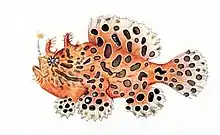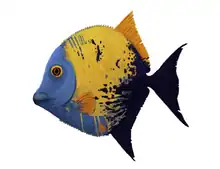| Neopterygii Temporal range: | |
|---|---|
 | |
| Siganus corallinus (a teleost) | |
 | |
| Lepisosteus oculatus (a holostean) | |
| Scientific classification | |
| Domain: | Eukaryota |
| Kingdom: | Animalia |
| Phylum: | Chordata |
| Class: | Actinopterygii |
| (unranked): | Actinopteri |
| Subclass: | Neopterygii Regan, 1923[2] |
| Infraclasses | |
|
Holostei | |
Neopterygii (from Greek νέος neos 'new' and πτέρυξ pteryx 'fin') is a subclass of ray-finned fish (Actinopterygii). Neopterygii includes the Holostei and the Teleostei, of which the latter comprise the vast majority of extant fishes, and over half of all living vertebrate species.[3] While living holosteans include only freshwater taxa, teleosts are diverse in both freshwater and marine environments. Many new species of teleosts are scientifically described each year.[3]
Fossil evidence for crown group neopterygians goes back at least 251 million years to the Induan stage of the Early Triassic epoch,[4][5][6] however, one study incorporating morphological data from fossils and molecular data from nuclear and mitochondrial DNA, places this divergence date at least 284 mya (million years ago), during the Artinskian stage of the Early Permian.[1] Another study suggests an even earlier split (360 myr ago, near the Devonian-Carboniferous boundary).[7]
| Vertebrates |
| |||||||||||||||||||||||||||||||||||||||||||||
Evolution and diversity
Living neopterygians are subdivided into two main groups (infraclasses): teleosts and holosteans.[8] Holosteans comprise two clades, the Ginglymodi and the Halecomorphi.[9][3][10][11] All of these groups have a long and extensive fossil record.[12] The evolutionary relationships between the different groups of Neopterygii is summarized in the cladogram below (divergence time for each clade in mya are based on[7]).
| Neopterygii 360 mya |
| ||||||||||||
Neopterygians are a very speciose group. They make up over 50% of the total vertebrate diversity today, and their diversity grew since the Mesozoic era.[12][13] However, the diversity of the various groups of neopterygians (or of fishes in general) is unevenly distributed, with teleosts making up the vast majority (96%) of living species.[3]

Early in their evolution, neopterygians were a very successful group of fish, because they could move more rapidly than their ancestors. Their scales and skeletons began to lighten during their evolution, and their jaws became more powerful and efficient.[3] While electroreception and the ampullae of Lorenzini are present in all other groups of fish, with the exception of hagfish (although hagfish are not actinopterygians, they are agnathans), neopterygians have lost this sense, even if it has later been re-evolved within Gymnotiformes and catfishes, which possess non-homologous teleost ampullae.[14]
Only a few changes occurred during the evolution of neopterygians from the earlier actinopterygians. However, a very important step in the evolution of neopterygians is the acquisition of a better control of the movements of both dorsal and anal fins, resulting in an improvement in their swimming capabilities. They additionally acquired several modifications in the skull, which allowed the evolution of different feeding mechanisms and consequently the colonization of new ecological niches. All of these characters represented major improvements, resulting in Neopterygii becoming the dominant group of fishes (and, thus, taxonomically of vertebrates in general) today.[12]
The great diversity of extant teleosts has been linked to a whole genome duplication event during their evolution.[15]
Classification
- Order †Pholidopleuriformes
- Order †Redfieldiiformes
- Order †Platysiagiformes
- Order †Polzbergiiformes
- Order †Perleidiformes
- Order †Louwoichthyiformes[16]
- Order †Peltopleuriformes
- Order †Luganoiiformes
- Order †Pycnodontiformes
- Infraclass Holostei
- Clade Halecomorphi
- Order †Parasemionotiformes
- Order †Panxianichthyiformes
- Order †Ionoscopiformes
- Order Amiiformes, the bowfin
- Clade Ginglymodi
- Order †?Dapediiformes
- Order †Semionotiformes
- Order Lepisosteiformes, the gars
- Clade Halecomorphi
- Clade Teleosteomorpha
- Order †Prohaleciteiformes
- Division Aspidorhynchei
- Order †Aspidorhynchiformes
- Order †Pachycormiformes
- Infraclass Teleostei
- Order †?Araripichthyiformes
- Order †?Ligulelliiformes
- Order †Pholidophoriformes
- Order †Dorsetichthyiformes
- Order †Leptolepidiformes
- Order †Crossognathiformes
- Order †Ichthyodectiformes
- Order †Tselfatiiformes
- Superorder Osteoglossomorpha
- Order †Lycopteriformes
- Order Osteoglossiformes, the bony-tongued fishes
- Order Hiodontiformes, including the mooneye and goldeye
- Superorder Elopomorpha
- Order Elopiformes, including the ladyfishes and tarpon
- Order Albuliformes, the bonefishes
- Order Notacanthiformes, including the halosaurs and spiny eels
- Order Anguilliformes, the true eels
- Order Saccopharyngiformes, including the gulper eel
- Superorder Clupeomorpha
- Order †Ellimmichthyiformes
- Order Clupeiformes, including herrings and anchovies
- Superorder Ostariophysi
- Order †Sorbininardiformes
- Order Gonorynchiformes, including the milkfishes
- Order Cypriniformes, including barbs, carp, danios, goldfishes, loaches, minnows, rasboras
- Order Characiformes, including characins, pencilfishes, hatchetfishes, piranhas, tetras.
- Order Gymnotiformes, including electric eels and knifefishes
- Order Siluriformes, the catfishes
- Superorder Lepidogalaxii
- Order Lepidogalaxiiformes, the salamanderfish
- Superorder Protacanthopterygii
- Order Argentiniformes, including the barreleyes and slickheads (formerly in Osmeriformes)
- Order Salmoniformes, including salmon, Arctic char, and trout
- Order Esociformes, the pikes and mudminnows
- Order Galaxiiformes, the galaxiids
- Order Osmeriformes, including the smelts
- Superorder Stenopterygii (may belong in Protacanthopterygii)
- Order Ateleopodiformes, the jellynose fish
- Order Stomiiformes, including the bristlemouths and marine hatchetfishes
- Superorder Cyclosquamata (may belong in Protacanthopterygii)
- Order Aulopiformes, including the Bombay duck, tripod fish, and lancetfishes
- Superorder Scopelomorpha
- Order Myctophiformes, including the lanternfishes
- Superorder Lampridiomorpha
- Order Lampriformes, including the oarfish, opah and ribbonfishes
- Superorder Polymyxiomorpha
- Order †Pattersonichthyiformes
- Order †Ctenothrissiformes
- Order Polymixiiformes, the beardfishes
- Superorder Paracanthopterygii
- Order Percopsiformes, including the cavefishes and trout-perches
- Order †Sphenocephaliformes
- Order Batrachoidiformes, the toadfishes
- Order Lophiiformes, including the anglerfishes
- Order Gadiformes, including cods
- Order Ophidiiformes, including the pearlfishes
- Superorder Acanthopterygii
- Order Mugiliformes, the mullets
- Order Atheriniformes, including silversides and rainbowfishes
- Order Beloniformes, including the flyingfishes
- Order Cetomimiformes, the whalefishes
- Order Cyprinodontiformes, including live-bearers, killifishes
- Order Stephanoberyciformes, including the ridgeheads
- Order Beryciformes, including the fangtooths and pineconefishes
- Order Zeiformes, including the dories
- Order Gobiesociformes, the clingfishes[17]
- Order Gasterosteiformes including sticklebacks
- Order Syngnathiformes, including the seahorses and pipefishes[18]
- Order Synbranchiformes, including the swamp eels
- Order Tetraodontiformes, including the sunfish, filefishes and pufferfish
- Order Pleuronectiformes, the flatfishes
- Order Scorpaeniformes, including scorpionfishes and the sculpins
- Order Perciformes 40% of all fish including anabantids, bass, cichlids, gobies, gouramis, mackerel, perches, scats, whiting, wrasses
References
- 1 2 Hurley, Imogen A.; Mueller, Rachael Lockridge; Dunn, Katherine A. (21 November 2006). "A new time-scale for ray-finned fish evolution". Proceedings of the Royal Society B. 274 (1609): 489–498. doi:10.1098/rspb.2006.3749. PMC 1766393. PMID 17476768.
- ↑ Regan, C. Tate (1923). "The Skeleton of Lepidosteus, with remarks on the origin and evolution of the lower Neopterygian Fishes". Journal of Zoology. 93 (2): 445–461. doi:10.1111/j.1096-3642.1923.tb02191.x.
- 1 2 3 4 5 Nelson, Joseph, S. (2016). Fishes of the World. John Wiley & Sons, Inc. ISBN 978-1-118-34233-6.
{{cite book}}: CS1 maint: multiple names: authors list (link) - ↑ Olsen, P.E. (1984). "The skull and pectoral girdle of the parasemionotid fish Watsonulus eugnathoides from the Early Triassic Sakamena Group of Madagascar, with comments on the relationships of the holostean fishes". Journal of Vertebrate Paleontology. 4 (3): 481–499. Bibcode:1984JVPal...4..481O. doi:10.1080/02724634.1984.10012024.
- ↑ Gardiner, B. G. (1993). "Osteichtythyes: basal actinopterygians". Fossil Record II.
- ↑ Grande, Lance; Bemis, William E. (1998). "A Comprehensive Phylogenetic Study of Amiid Fishes (Amiidae) Based on Comparative Skeletal Anatomy. an Empirical Search for Interconnected Patterns of Natural History". Journal of Vertebrate Paleontology. 18 (Supplementary 1): 1–696. Bibcode:1998JVPal..18S...1G. doi:10.1080/02724634.1998.10011114.
- 1 2 Thomas J. Near; et al. (2012). "Resolution of ray-finned fish phylogeny and timing of diversification". PNAS. 109 (34): 13698–13703. Bibcode:2012PNAS..10913698N. doi:10.1073/pnas.1206625109. PMC 3427055. PMID 22869754.
- ↑ López-Arbarello, A (2012). "Phylogenetic Interrelationships of Ginglymodian Fishes (Actinopterygii: Neopterygii)". PLOS ONE. 7 (7): e39370. Bibcode:2012PLoSO...739370L. doi:10.1371/journal.pone.0039370. PMC 3394768. PMID 22808031.
- ↑ Betancur-R (2016). "Phylogenetic Classification of Bony Fishes Version 4".
- ↑ "Actinopterygii". Integrated Taxonomic Information System. Retrieved 3 April 2006.
- ↑ R. Froese and D. Pauly, ed. (February 2006). "FishBase".
- 1 2 3 Friedman, Matt; Sallan, Lauren Cole (June 2012). "Five hundred million years of extinczion and recovery: A Phanerozoic survey of large-scale diversity patterns in fishes". Palaeontology. 55 (4): 707–742. Bibcode:2012Palgy..55..707F. doi:10.1111/j.1475-4983.2012.01165.x. S2CID 59423401.
- ↑ Romano, Carlo; Koot, Martha B.; Kogan, Ilja; Brayard, Arnaud; Minikh, Alla V.; Brinkmann, Winand; Bucher, Hugo; Kriwet, Jürgen (February 2016). "Permian-Triassic Osteichthyes (bony fishes): diversity dynamics and body size evolution". Biological Reviews. 91 (1): 106–147. doi:10.1111/brv.12161. PMID 25431138. S2CID 5332637.
- ↑ Electroreception By Theodore Holmes Bullock
- ↑ Pasquier, Jeremy; Braasch, Ingo; Batzel, Peter; Cabau, Cedric; Montfort, Jérome; Nguyen, Thaovi; Jouanno, Elodie; Berthelot, Camille; Klopp, Christophe; Journot, Laurent; Postlethwai, John H.; Guigue, Yann; Bob, Julien (2017). "Evolution of gene expression after whole-genome duplication: new insights from the spotted gar genome". J Exp Zool (Mol Dev Evol). 328 (7): 709–721. Bibcode:2017JEZB..328..709P. doi:10.1002/jez.b.22770. PMC 5679426. PMID 28944589.
- ↑ Xu, Guang-Hui (2021-01-09). "A new stem-neopterygian fish from the Middle Triassic (Anisian) of Yunnan, China, with a reassessment of the relationships of early neopterygian clades". Zoological Journal of the Linnean Society. 191 (2): 375–394. doi:10.1093/zoolinnean/zlaa053. ISSN 0024-4082.
- ↑ In ITIS, Gobiesociformes is placed as the suborder Gobiesocoidei of the order Perciformes.
- ↑ In ITIS, Syngnathiformes is placed as the suborder Syngnathoidei of the order Gasterosteiformes.
.png.webp)
.jpg.webp)






